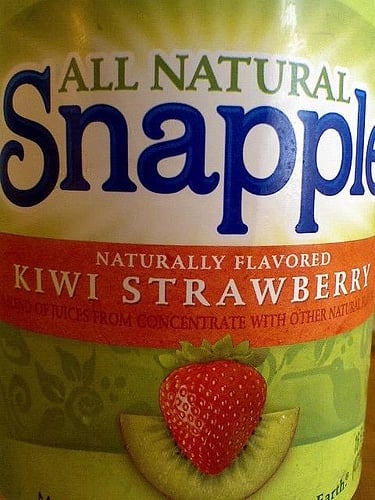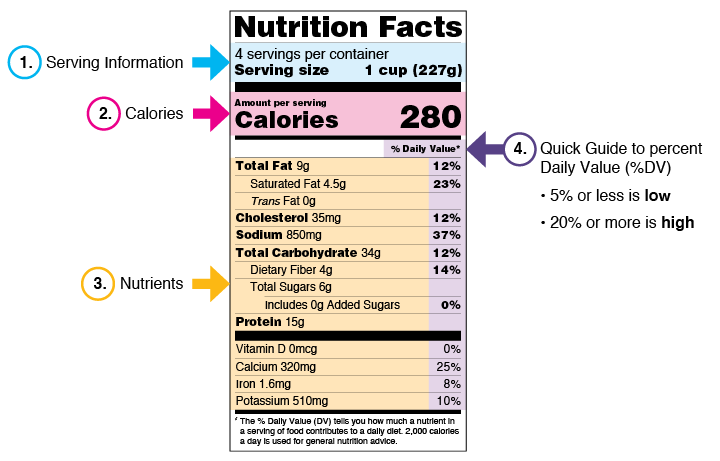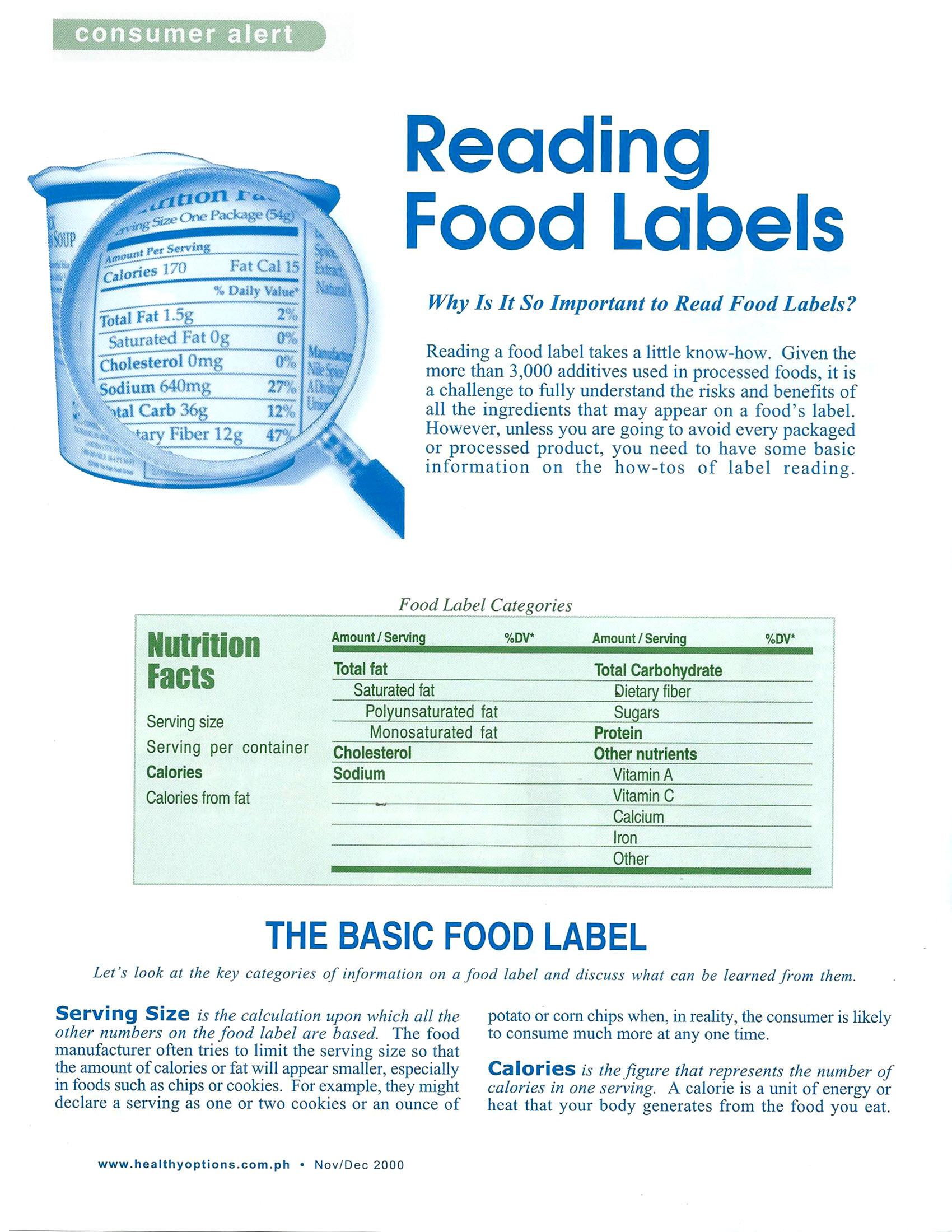39 reading calories on food labels
How To Read Food Labels - Fit Me Solution But because the current Daily Value for calcium on food labels is 1000 milligrams (and the proposed is 1300), 1 milligram of calcium is a negligible amount. Front-of-Package Labels. Some consumers find the many numbers on Nutrition Facts panels overwhelming. They want an easier and quicker way to interpret information and select products. Learning To Read Labels :: Diabetes Education Online When you read food labels, the grams of sugar are already included in the total carbohydrate amount, so you do not need to count this sugar amount separately. The grams of sugar listed include both natural sugars, from fruit or milk, and added sugars. On a nutrition food label, the total carbohydrate includes the sugar. Some Nutrition Facts ...
PDF How to Read the Food Label - Risk Services This is the number of calories you'll eat in one serving of a food. Calories needed each day depends on your age, sex, height, weight, and amount of physical activity. Estimates range from 1,600 to 2,400 calories for women and 2,000 to 3,000 calories for men. If you're trying to lose weight, avoid or limit high-calorie foods.

Reading calories on food labels
kidshealth.org › en › teensFood Labels (for Teens) - Nemours KidsHealth A food with 5% or less of a nutrient is low in that nutrient. A food with 10%–19% of a nutrient is a good source of that nutrient. A food with 20% or more of a nutrient is high in that nutrient. The information on food labels is based on an average adult diet of 2,000 calories per day. How to Read Nutrition Facts Labels the Right Way - GoodRx A good goal is to aim to consume the following amounts of protein during the day: At each meal: 20 to 30 g (about one small chicken breast or fish filet) With snacks: About 10 to 15 g (about two eggs or half a cup of Greek-style yogurt) Also, keep in mind that more isn't necessarily better. › understanding-food-labelsUnderstanding food labels - Canada.ca Find information on food labels and how to understand them. Learn about nutrition facts tables, serving size, list of ingredients, % daily value and nutrition claims.
Reading calories on food labels. PDF How Do I Understand the "Nutrition Facts" Label? a day, this is 120 calories or less, or about 13 grams of saturated fat. Most foods in the grocery store have a Nutrition Facts label and ingredient list. When you go grocery shopping, take time to read the Nutrition Facts labels on the foods you purchase. Compare the nutrients and calories in one food to those in another. The How to Read a Nutrition Facts Label - Everyday Health Lower sodium limit Food labels reflect the new, slightly lower RDA of 2,300 milligrams (mg) per day (down from 2,400 mg per day). How to Read a Nutrition Facts Label First, know that, as the label... Understanding food labels - Canada.ca Food labels, nutrition facts tables, serving size, ingredients, % daily value, nutrition claims. Services and information. Nutrition facts tables. How to use, what is in them, foods that don't have a nutrition facts table. Serving size. How to use the serving size on nutrition facts tables. List of ingredients . About list of ingredients on packaged foods, common terms used for some ... Four Week Emergency Food Supply, Averages 2,000+ Calories per … 08.07.2022 · CALORIES = ENERGY = SURVIVAL. Our 4-Week Food Supply provides one person with an average of over 2,000 calories per day for 28 days.. Remember, calories are crucial to survival! Other companies skimp on calories, which isn’t just wrong—it’s reckless. You won’t be satisfied with 1,500 calories, and 1,300 calories will leave you starving.
Reading Nutrition Labels - Cronometer Reading Nutrition Labels Hilary March 31, 2021 23:00; ... see on nutrition labels is a standardized value used for nutrition labels to help people better understand amounts on labels. In the Cronometer Calories Summary, the Nutrient Targets show your nutrition targets for the day. Each target has an optional minimum and maximum value. How to read food labels: MedlinePlus Medical Encyclopedia If you eat 2 cups (0.48 liters) at a meal, you are eating 2 servings. That is 2 times the amount of the calories, fats, and other nutrients listed on the label. Calorie information tells you the number of calories in 1 serving. Adjust the number of calories if you eat smaller or larger portions. Food Labels (for Teens) - Nemours KidsHealth A food with 5% or less of a nutrient is low in that nutrient. A food with 10%–19% of a nutrient is a good source of that nutrient. A food with 20% or more of a nutrient is high in that nutrient. The information on food labels is based on an average adult diet of 2,000 calories per day. The actual number of calories and nutrients that kids ... How to Read Nutrition Facts | Food Labels Made Easy - YouTube To support our channel and level up your health, check out:Our Fast Weight Loss Course: B...
The Basics of the Nutrition Facts Label Step 4: Check Out the Nutrition Terms. Low calorie: 40 calories or less per serving. Low cholesterol: 20 milligrams or less and 2 grams or less of saturated fat per serving. Reduced: At least 25% less of the specified nutrient or calories than the usual product. Good source of: Provides at least 10 to 19% of the Daily Value of a particular ... food-guide.canada.ca › using-food-labelsUse food labels - Canada's Food Guide Oct 14, 2020 · Using food labels can help you compare and choose products so you can make an informed choice. On this page Benefits of using food labels Changes to food labels How to use food labels Benefits of using food labels Food labels provide information you can use to make informed choices about foods and drinks at the grocery store and at home. Food labels can help you: Reading and Understanding Food Labels and Nutrition Info - Beaumont Health Many fresh meats, poultry and fish do not have a nutrition facts label. The average cholesterol per ounce of an animal product is 25 mg. Percent of calories from fat Divide the calories from fat by the total calories. Keep in mind not every food you eat needs to contain less than 30 percent of the calories from fat. › en › healthy-livingUnderstanding Ingredients on Food Labels | American Heart ... Food labels are an important source of information about calories and the nutritional value of the foods you eat, a crucial tool in building a heart-healthy diet. The Nutrition Facts information is always displayed in the same orderly fashion and helps you understand how much of certain nutrients that you need to limit are contained in the ...
What Do Calories Mean in Food and Exercise? - Verywell Fit 12.10.2021 · Calories in food are grouped as fats, alcohol, carbohydrates, and proteins. Different nutrients have more or fewer calories packed into the same weight (higher or lower calorie density). Nutrition labels in the U.S. use these rules of thumb: Alcohol: 1 gram of alcohol has 7 calories (kcal) Carbohydrate: 1 gram of carbohydrate (sugars and starches) has 4 …
How to Read Nutrition Labels - Verywell Fit The column on the right side of the nutrition label has numbers displayed in percentages. The numbers listed under "% Daily Value" tell you how much a particular nutrient contributes to your total daily diet if you consume 2,000 calories per day. If you consume more or less than 2,000 calories per day, these figures will not be accurate for you.
A Guide to Reading Food Labels - University of Rochester 27.02.2013 · A Guide to Reading Food Labels Reading food labels can help you make wise food choices. Most foods list nutrition information on the package label, called Nutrition Facts. These facts can help you compare foods and choose the healthiest option. Sample Label 1 Serving Size Calories . Limit These . Nutrients . Get Enough of These Nutrients 5 Nutrition …
Quick Tips for Reading the Nutrition Facts Label To create your Tip Card: 1. Use a pair of scissors to cut along the dotted lines. 2. Fold along the center line. 3. Keep the Tip Card in your wallet or purse. Calories230 Amount per serving Serving...
Food label reading guide | Nutrition Australia What to look for when reading food and drink labels (per 100g) Health Star Ratings The Health Star Rating is a front of pack labelling scheme which can be used to make healthier food choices at a glance. The rating range is from ½ - 5 stars and the more stars, the healthier the choice. Recommended minimum star ratings for food and drink categories
5 tips for decoding food labels - Harvard Health If the label says 125 calories per 8 ounce serving and your breakfast includes a 16 ounce glass of OJ, then you've taken in 250 calories from the juice alone. (About as many calories as you'd find in many chocolate bars.) Look for fat: the good, the bad, and the really bad. Check the saturated fat and trans fat content of the food.
Food Labels 101: Understanding the Nutrition Facts Label Nutrition labels are based on a daily 2,000 calorie diet. Depending on your age, gender and activity level, you may need to consume more or less than 2,000 calories per day, so keep this in mind when viewing each label. Now let's take a look at the parts of the nutrition facts label and break it all down. Anatomy of a Nutrition Facts Label
How Do They Calculate Calories on Food Labels? 5 grams of fat (5 x 9 = 45 calories) 22 grams of carbohydrate (22 x 4 = 88 calories) 2 grams of protein (2 x 4 = 8) ...should contain approximately 140 calories. It's important to recognize that 4-9-4 is an average, and not an exact amount. For example, 1 gram of fat in one food may yield 8.34 calories while 1 gram of fat from another food ...






Post a Comment for "39 reading calories on food labels"